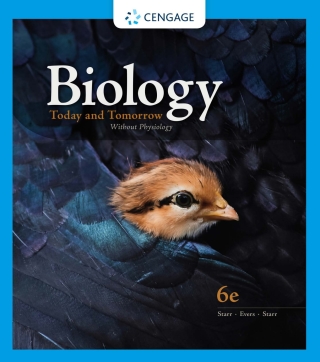Buy Biology Today and Tomorrow Without Physiology, 6th Edition PDF ebook by author Cecie Starr; Christine Evers; Lisa Starr – published by Cengage Learning in 2021 and save up to 80% compared to the print version of this textbook. With PDF version of this textbook, not only save you money, you can also highlight, add text, underline add post-it notes, bookmarks to pages, instantly search for the major terms or chapter titles, etc.
You can search our site for other versions of the Biology Today and Tomorrow Without Physiology, 6th Edition PDF ebook. You can also search for others PDF ebooks from publisher Cengage Learning, as well as from your favorite authors. We have thousands of online textbooks and course materials (mostly in PDF) that you can download immediately after purchase.
Note: e-textBooks do not come with access codes, CDs/DVDs, workbooks, and other supplemental items.
eBook Details:
Full title: Biology Today and Tomorrow Without Physiology, 6th Edition
Edition: 6th
Copyright year: 2021
Publisher: Cengage Learning
Author: Cecie Starr; Christine Evers; Lisa Starr
ISBN: 9780357127551, 9780357127742
Format: PDF
Description of Biology Today and Tomorrow Without Physiology, 6th Edition:
The Sixth Edition of BIOLOGY TODAY AND TOMORROW WITHOUT PHYSIOLOGY helps students build critical-thinking skills they will use as responsible, science-literate citizens. Packed with beautiful art and current applications, the book’s straightforward writing style and chunked content help students grasp the fundamentals of biology without overwhelming them with detail. Content updates reflect current research, new technology and the social implications of both, while active learning tools are woven into the narrative and art.Important Notice: Media content referenced within the product description or the product text may not be available in the ebook version.
Table of Contents of Biology Today and Tomorrow Without Physiology, 6th Edition PDF ebook:
Brief ContentsContentsPrefaceAcademic AdvisorsStudent and Instructor ResourcesChapter 1: Invitation to Biology1.1 The Secret Life of Earth 1.2 Life Is More Than the Sum of Its Parts 1.3 How Living Things Are Alike 1.4 How Living Things Differ 1.5 The Science of Nature 1.6 Analyzing Experimental Results 1.7 The Nature of Science SummaryChapter 2: Molecules of Life2.1 A Big Fat Problem 2.2 Atoms 2.3 Chemical Bonds 2.4 Special Properties of Water 2.5 Acids and Bases 2.6 The Chemistry of Biology 2.7 Carbohydrates 2.8 Lipids 2.9 Proteins 2.10 Nucleic Acids SummaryChapter 3: Cell Structure3.1 Food for Thought 3.2 What Is a Cell? 3.3 Cell Membrane Structure 3.4 Prokaryotic Cells 3.5 Eukaryotic Organelles 3.6 Elements of Connection 3.7 The Nature of Life SummaryChapter 4: Energy and Metabolism4.1 A Toast to Alcohol Dehydrogenase 4.2 Life Runs on Energy 4.3 Energy in the Molecules of Life 4.4 Enzymes and Metabolic Pathways 4.5 Diffusion across Membranes 4.6 Membrane Transport Mechanisms SummaryChapter 5: Photosynthesis5.1 A Burning Concern 5.2 Overview of Photosynthesis 5.3 Light Energy 5.4 Light-Dependent Reactions 5.5 Light-Independent Reactions SummaryChapter 6: Releasing Chemical Energy6.1 Risky Business 6.2 Carbohydrate Breakdown Pathways 6.3 Aerobic Respiration 6.4 Fermentation 6.5 Food as a Source of Energy SummaryChapter 7: DNA Structure and Function7.1 A Hero Dog’s Golden Clones 7.2 The Function of DNA 7.3 The Structure of DNA 7.4 Eukaryotic Chromosomes 7.5 DNA Replication 7.6 Mutations SummaryChapter 8: Gene Expression and Control8.1 Ricin, RIP 8.2 DNA, RNA, and Gene Expression 8.3 Transcription: DNA to RNA 8.4 RNAs in Translation 8.5 Translation: RNA to Protein 8.6 Products of Mutated Genes 8.7 Control of Gene Expression SummaryChapter 9: How Cells Reproduce9.1 Henrietta’s Immortal Cells 9.2 Multiplication by Division 9.3 Mitosis and Cytoplasmic Division 9.4 Cell Cycle Control 9.5 Sex and Alleles 9.6 Meiosis in Sexual Reproduction SummaryChapter 10: Patterns of Inheritance10.1 Menacing Mucus 10.2 Tracking Traits 10.3 Mendelian Inheritance Patterns 10.4 Non-Mendelian Inheritance 10.5 Complex Variation in Traits 10.6 Human Genetic Analysis 10.7 Inheritance Patterns in Humans 10.8 Changes in Chromosome Number 10.9 Genetic Testing SummaryChapter 11: Biotechnology11.1 Personal Genetic Testing 11.2 Working with DNA 11.3 Studying DNA 11.4 Genetic Engineering 11.5 Editing Genomes SummaryChapter 12: Evidence of Evolution12.1 Reflections of a Distant Past 12.2 Old Beliefs, New Discoveries 12.3 Natural Selection 12.4 Fossil Evidence 12.5 Changes in the History of Earth 12.6 Evidence in Form and Function 12.7 Molecular Evidence SummaryChapter 13: Processes of Evolution13.1 Farming Superbugs 13.2 Alleles in Populations 13.3 Patterns of Natural Selection 13.4 Natural Selection and Diversity 13.5 Nonselective Evolution 13.6 Speciation 13.7 Macroevolution 13.8 Phylogeny SummaryChapter 14: Prokaryotes, Protists, and Viruses14.1 The Human Microbiota 14.2 Origin of Cellular Life 14.3 Early Life 14.4 Modern Bacteria and Archaea 14.5 Origin of Eukaryotes 14.6 Protists 14.7 Viruses SummaryChapter 15: Plants and Fungi15.1 Fungal Threats to Crops 15.2 Plant Traits and Evolution 15.3 Nonvascular Plants 15.4 Seedless Vascular Plants 15.5 Rise of the Seed Plants 15.6 Gymnosperms 15.7 Angiosperms-Flowering Plants 15.8 Fungal Traits and Diversity 15.9 Ecological Roles of Fungi SummaryChapter 16: Animal Evolution16.1 Medicines from the Sea 16.2 Traits and Evolutionary Trends 16.3 Sponges and Cnidarians 16.4 Flatworms, Annelids, and Mollusks 16.5 Roundworms and Arthropods 16.6 Echinoderms and Chordates 16.7 Fishes and Amphibians 16.8 Escape from Water- Amniotes 16.9 Primate and Human Evolution SummaryChapter 17: Population Ecology17.1 Managing Canada Geese 17.2 Characteristics of Populations 17.3 Models of Population Growth 17.4 Life History Patterns 17.5 Human Populations SummaryChapter 18: Communities and Ecosystems18.1 Invasion of the Red Imported Fire Ants 18.2 Community Structure 18.3 Direct Species Interactions 18.4 How Communities Change 18.5 The Nature of Ecosystems 18.6 The Water, Nitrogen, and Phosphorus Cycles 18.7 The Carbon Cycle and Climate Change SummaryChapter 19: The Biosphere and Human Effects19.1 Decline of the Monarchs 19.2 Climate and the Distribution of Biomes 19.3 Forest Biomes 19.4 Grasslands, Chaparral, Deserts, and Tundra 19.5 Aquatic Ecosystems 19.6 Global Effects of Pollution 19.7 Conservation Biology SummaryAppendix I: Answers to Self-QuizzesAppendix II: Periodic Table of the ElementsAppendix III: A Plain English Map of the Human ChromosomesGlossaryIndex





